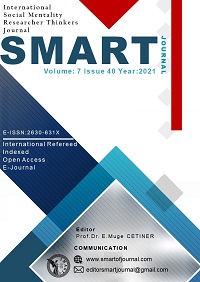Author :
Abstract
Keywords
Abstract
The most important value and purpose of human life is happiness. Happiness can be expressed as a state of feeling full of energy and being in a good mood. Happiness is not a kind of concept that exists only in social life and gives people motivation for social life. Many factors in working life will also affect people's happiness or unhappiness. Happiness in business life occurs with many positive attitudes and behaviors such as positive social relationships, appreciation, love, achievement, as well as positive evaluation of the work and working conditions. Thanks to happiness subjective well-being in business life affects the well-being of the group, this is reflected in the work done. According to the 2019 happiness report published by the United Nations, the study examines the correlation between working hours and happiness by comparing the ten happiest countries and the ten unhappiest countries in the world in terms of their legal working hours. In the study, a case study research design, one of the qualitative research methods, was used. The obtained data were analyzed by the content analysis method.
Keywords
- Andrews, F. M., & Withey, S. B. (1976). Social indicators of well-being: America’s perception of life
- Andrews, F. M., & Withey, S. B. (1976). Social indicators of well-being: America’s perception of life quality. New York: Plenum. doi:10.1007/978-1-4684-2253-5.
- Altunışık, R., Coşkun, R., Bayraktaroğlu, S., & Yıldırım, E. (2010). Sosyal Bilimlerde Araştırma Yöntemleri SPSS Uygulamalı (6. Baskı). Sakarya: Sakarya Yayıncılık.
- Chaiprasit K., Santidhirakul, O. (2011). Happiness at Work of Employees in Small and Medium-sized Enterprises, Thailand, Procedia - Social and Behavioral Sciences, 25: 191.
- Canpolat, E.(2018). Mutlu Beyin. PsiNossa Bir Psikoloji Dergisi 1 (44), 8-9.
- Çalışkan, K. (2010), Mutluluk, İçinde: Kurumlarda İyilik de Var, Edt: Güler İslamoğlu, Nobel Yayın Dağıtım, Ankara.
- Diener, E. (2006). “Guidelines for National Indicators of Subjective Well–Being and Ill-Being”, Journal of Happiness Studies, 7 (4): 400- 404.
- Diener, E., Emmons, A., R., Larsen, J.,R., Grıffın S., (1985). The Saticfaction With Life Scale, Journal Of Personality Assesment, 49 (1) :71.
- Gökberk, M. (1967). Felsefe Tarihi, Ankara : Bilgi Yayınevi.
- Happiness At Work Index (2007). Happiness at Work, Retrieved June 12, 2013, from http://www.arboraglobal.com/documents/Happiness%20at%20Work%20 Index%202007.pdf
- Koçel, (2018). İşletme Yöneticiliği: Beta Yayınevi, İstanbul.
- Lin, H.F. (2013). The Well-Being of Junior High School Students in Taiwan in Relation to Familial Socioeconomic Status, School Life Adjustment, and Deviant Behavior. Psychology, 3: 217- 223.
- Maenapothi, R. (2007). Happiness in the Workplace Indicator. Master’s Thesis. Human Resource Development.National Institute of Development Administration.
- Nazlı, M. (2015). Hizmet Sektöründe Kurumsal Yönetimin İşte Mutluluk Üzerine Etkisi. Yaşar Üniversitesi Sosyal Bilimler Enstitüsü İşletme Ana Bilim Dalı. Yayınlanmamış Doktora Tezi.
- Örs, H. (1962). Epikür’ün Hayatı ve Felsefesi: Remzi Kitabevi.
- Vatansever, Çiğdem (2008). İş ve İş Dışı Yaşam Dengesi ve Örgüte Bağlılık İle Kariyer Tatmini İlişkisi. Marmara Üniversitesi Sosyal Bilimler Enstitüsü. Yayınlanmamış Doktora Tezi.
- Yıldırım, A., Şimşek, H. (2008). Sosyal Bilimlerde Nitel Araştırma Yöntemleri (6. Baskı). Ankara: Seçkin Yayıncılık.
- https://s3.amazonaws.com/happinessreport/2019, Erişim Tarihi: 26.12.2019. https://ilostat.ilo.org/data/country-profiles, Erişim Tarihi: 20.12.2019.





